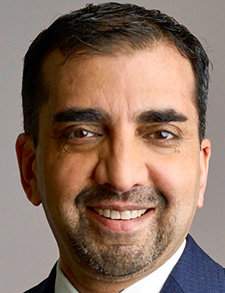 Physician advisors are responsible for a lot. Their work exists at the intersection of clinical matters and revenue. Think clinical documentation, hospital quality measures, length-of-stay management, utilization review, and the check-box difference between observation and inpatient status.
Physician advisors are responsible for a lot. Their work exists at the intersection of clinical matters and revenue. Think clinical documentation, hospital quality measures, length-of-stay management, utilization review, and the check-box difference between observation and inpatient status.
So, of course, most of them are hospitalists, given the quarterback-like role in clinical care the specialty plays.

Dr. Ansari
“The majority of physician advisors are hospitalists because we are natural experts in understanding hospital operations and managing patients in the hospital,” said Aziz Ansari, DO, FAAHPM, FACP, SFHM, professor of medicine and associate chief medical officer of clinical optimization and revenue integrity at Loyola University Medical Center in Maywood, Ill.
“It’s the natural next step for a hospitalist to take on additional roles if they choose to. Because there are so many hospitalists who are physician advisors, there was a big need and a want to have an organized forum within the Society of Hospital Medicine, where physician advisors can congregate, learn, and support each other,” Dr. Ansari said.
So was born the Physician Advisors Special Interest Group, which Dr. Ansari took over as chair in 2022.
“It is vital that there is a forum where the physician advisors can get together, learn from each other, and offer insights to continue to improve hospital operations and hospital financial and quality metrics,” he said.
For Dr. Ansari, the SIG is a necessary community that gives physician advisors a place to share pearls, pitfalls, successes, and challenges.
“A lot of us think we’re alone in this big fight with insurance companies, with keeping our lifeboats open and trying to maximize revenue integrity and quality metrics,” he said. “You realize that the same challenges you’re having are the same as others and you are not alone. That sense of community and camaraderie, sharing best practices, and sharing war stories are very helpful for your sanity. And we can learn together to improve and do what’s best for our patients collectively.”
Dr. Ansari says learning what other physician advisors have done in their workflows gives SIG members the confidence to defend their positions to administrators in their respective institutions.
“One can go to their C-suite and say, ‘We’re not the only ones struggling here, and I’ve networked with X, Y, or Z health care system,’ and saying, ‘Hey, there is an idea that one of my colleagues had, and we can try this.’” Dr. Ansari said. “Or, if a C-suite member feels like they are the only ones with a certain problem, well, you have a whole network of colleagues who will tell you you’re not alone.”
Dr. Ansari says that a communal approach to improvement can be as high-level as a conversation with C-suites and as granular as what programs to use.
“It’s a lot of sharing of ideas and what methods have been tried to improve metrics in various domains, and also learning from others what did not work, if people are willing to share,” he said. “This can be very helpful, especially for those with less experience and just starting their career as a physician advisor.”
The SIG also aims to be forward-looking to help physician advisors deal with the ever-changing health care landscape.
“For example, Medicare Advantage came out with a rule in January 2024 that says that Medicare Advantage must follow the two-midnight rule,” Dr. Ansari said. “So, we’ve been spending some time trying to figure out what that means, collectively, and in February, we’re going to have a webinar on Medicare Advantage that will focus on what are the lessons learned in a panel discussion. This is an example of continuous learning, advocacy, building that sense of community.”
The SIG hosts roughly four webinars a year, plus its annual meeting, SHM Converge. The webinars are always available to members to review later, as the topics aim to be more universal with evergreen content.
“That repository of webinars is accessible,” he said. “These are topics that hopefully can stand the test of time.”
Dr. Ansari is also clear that the SIG’s job isn’t to train physician advisors. A role like that is filled by the American College of Physician Advisors, as one example.
The SIG is there for support, networking, and mentorship.
“This is a great forum to find friends and colleagues who share your same interests and who can support each other,” Dr. Ansari said. “You’re not alone. This is a tough job. The answers may be right there in our community if we engage in dialogue.”
Richard Quinn is a freelance writer in New Jersey.
Great article . Clarified what actually these guys do and how important